6-3 Supporting Early Social and Emotional Development
There are many ways to support young children’s early social and emotional development. For this section, we will focus on supports offered in three areas:
- Responsiveness and contingency (how you respond to the child)
- Modeling (actions and interventions)
- Emotion language exposure (recognizing and labeling emotions in oneself and others)

A – Responsiveness
Ensuring responsiveness in children’s relationships with adults is one of the best ways to support children’s developing social and emotional skills, and it also supports their development overall.
As mentioned earlier, when children have trusting and loving relationships with caregivers, they can use those adults as secure bases for exploration and references for ambiguous or uncomfortable situations. Secure relationships with caregivers can even help to reduce any negative impacts from other aspects of children’s environments.
Responsiveness is more than just meeting a child’s needs. For infants, sensitive, synchronous relationships that are consistent are the best for establishing secure attachments and emotional development. But what does sensitive caregiving involve?
In Western cultures, one of the earliest ways that caregivers can show sensitive care to infants is through a form of communication called interactional synchrony. When interactions have synchrony, both partners share a mutual focus. They mirror each other’s emotions. They also respond to each other’s cues in a reciprocal and rhythmic manner.
For example, sharing positive emotions, such as mutual smiles and laughter, or responding to an infant’s cries or negative emotions, create synchrony.
Testing Interactional Synchrony
Maintaining a positive emotional expression alone is not enough to establish a secure adult-child relationship. When responsiveness is disrupted, children notice and are unsettled by the lack of connection between them and their caregiver.
In fact, researchers have tested the idea of synchrony and responsiveness using the still-face interaction that we learned about earlier in this lesson.
Infants who were 2, 4, and 6 months old participated in various still-face interactions. Sometimes the mother was instructed to keep a neutral face, as in the original still-face interaction, but other times she was used a happy or sad face during the still-face part of the interaction.
By 4 months, infants were upset by the still-face interaction regardless of what kind of face the mother presented. The disruption of responsiveness and synchrony between them and their mother upset them no matter what.
Even when the mother held a positive facial expression with a static happy face, infants still responded negatively to the lack of responsiveness.
Consistency
To establish a responsive relationship, a caregiver, educator, or parent must first recognize an infant’s signals.
Then they must determine what those signals mean and reliably respond to them. It’s okay if a caregiver misinterprets or misses an infant’s cue. Keep in mind that all caregivers are inconsistent and unresponsive sometimes. Yet most infants establish a loving bond with a parent or main caregiver.
The key is for the caregiver to make adjustments to increase consistent care during future interactions. Consistency is important not only in times of distress but also during play. This helps the child feel comfortable and secure.
When a caregiver is inconsistent, it’s hard for the child to know whether or how the caregiver will respond.
Expectations
Researchers have found a strong relationship between early attachment and future outcomes.
Researchers believe that attachment relates to future outcomes because attachment shapes children’s earliest expectations and assumptions about how relationships work.
Attachment relationships are the first relationships children form; if their attachment figure is warm and responsive to their needs, children will come to expect that other people also will be warm and responsive.
If you learn that others respond to you, you may be more likely to see yourself as loved and worthy of that love. Over time, this leads to more confident, well-adjusted children who believe they deserve attention and care.
Positive Outcomes
Generally, infants who have secure attachment relationships have better outcomes. Infants who have less secure relationships tend to have less positive outcomes. But the link between attachment behaviors and outcomes does not determine a child’s destiny. Plenty of children who are insecurely attached at an early age grow up to be well-adjusted adults.
Infants who have a history of secure relationships go on to have strong relationships with others. They have better relationships with peers and educators. They have a better understanding of emotions. They are more confident and have more complex beliefs about their abilities, traits, and values. They show more motivation to achieve in school.
They also tend to show fewer negative traits. For example, they have lower levels of anxiety, depression, and social withdrawal. They are also less likely to show aggressive behavior.
B – Modeling
Adult-child relationships also model appropriate behavior from an early age. An emotionally available adult demonstrates how to regulate and express emotions in an acceptable way. This helps children develop positive relationships with others and demonstrates how to address conflict in a productive way.
Researchers have found a significant link between parents’ own empathy and emotional expressiveness and children’s empathy.
Parents who show more empathy and are more likely to express their own emotions pass along valuable emotion information to their children who are then better able to develop their own emotional responses.
How to Study Modeling
Children are also gathering social and emotional information from watching the interactions between people around them.
In one study, researchers found that by the time they’re 18 months old, children can read other people’s emotions just by watching. The study involves a child watches a social interaction between two adults and uses that information to change their own behavior.
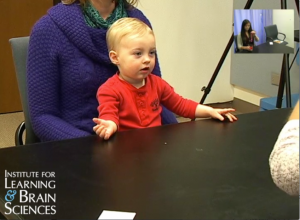 In the study, a woman showed a young child that dropping a bead necklace into a cup makes an interesting noise.
In the study, a woman showed a young child that dropping a bead necklace into a cup makes an interesting noise.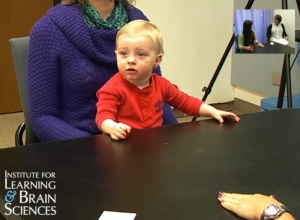 Then another woman comes into the room. When she watches the bead-cup toy, she yells that it’s “aggravating” and “so annoying.” You can see here that the infant is watching this interaction with a worried look.
Then another woman comes into the room. When she watches the bead-cup toy, she yells that it’s “aggravating” and “so annoying.” You can see here that the infant is watching this interaction with a worried look.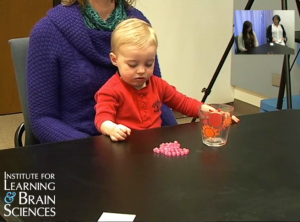 Finally, the infant is given a chance to play with the toys. Both women stay in the room, including the one who yelled about the bead-cup game being “annoying” and “aggravating.”
Finally, the infant is given a chance to play with the toys. Both women stay in the room, including the one who yelled about the bead-cup game being “annoying” and “aggravating.”In usual circumstances, the child would happily imitate the bead-cup game. And in fact, in another version of this study the aggravated woman leaves the room and children do imitate the bead-cup game. But when the aggravated woman remains in the room, the child is much less likely to play with the toys.
This suggests that children are learning from overhearing the interaction between the two women. Note that when the aggravated woman displayed her aggravation, it was only directed at the other woman, not the child.
It’s also interesting to note that children are able to pick up on mere tone. Most 18-month-old children do not have words like “aggravating” or “annoying” in their vocabularies. In this study, they’re picking up on social cues like the tone of voice that the aggravated woman was using, or the expressions on two women’s faces.
Children learn not just through direct interactions with adults, but also from overhearing or watching the social interactions between adults. Modeling can therefore occur both when interacting directly with children and also when interacting with other adults in the presence of children.
Using Modeling to Direct Behavior
How an adult behaves can really affect how children respond to a situation. In the image below, you can see an educator using a child’s natural tendency to imitate to walk them through an emotion-regulation exercise.
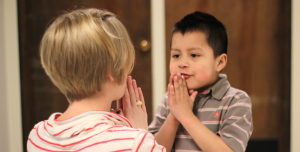
This knowledge about how effective modeling is suggests that before teaching a child something new, entering a family’s home during a visit, or introducing a child to a new toy or food, it can be helpful to think about how you want to shape their expectations.
They may not copy you the first time, but given how much children look to adults for cues, it can point them in the direction you want them to go.
This is also a great conversation to bring to other caregivers, such as parents. It’s impossible to set the perfect example all the time, but being mindful about what you’re saying and doing around children can go a long way.
C – Emotion Language Exposure
The more adults label and explain emotion positively with preschoolers, the better developed their emotional understanding. This is called emotional scaffolding.
This is the case with many concepts in life. Take color, for example. In Japan, the term mizu is used for what people in the U.S. would call light blue.
This is similar to the way that people in the U.S. use the term magenta instead of purplish-red. For people who are Japanese, mizu is as different from blue as green is from blue. It is not a shade of blue.
When someone from the U.S. sees one person wearing a light blue shirt and another person wearing a dark blue shirt, they may think, “What a nice blue shirt” for both people and not really think about the difference between the two shirts. But they wouldn’t say the same thing for one person wearing a purple shirt and another wearing a magenta shirt.
The same can be applied to emotions. Let’s say you lumped anger and sadness and guilt into one word: unpleasant. If you saw someone express anger, you might think that “someone is feeling unpleasant.” And if you saw someone else expressing sadness, you would again think that “someone is feeling unpleasant.” You might find it hard to distinguish between the two and respond to them differently.
Providing infants and toddlers with language to categorize different emotions in their own culture helps them recognize when different emotions are being expressed and that there may be different responses to those different emotions.
Emotion Language and Regulation
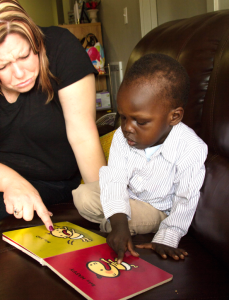
Research has shown that parents who talk about emotions more frequently and explain emotional experiences tend to have children with more elaborate and accurate understandings of emotions.
Language development provides children with a new way to understand and express how they feel. Rather than crying or throwing a toy, children can use language to share emotions such as, “I feel sad,” or “I feel mad.”
Remember that children develop recognition of different emotions at different times. Trying to teach a child younger than 20 months about self-conscious emotions such as guilt is difficult because they do not yet have an established sense of self.
Being aware of children’s growing sense of identity will help you tailor emotion vocabulary materials to a child’s self-awareness. When teaching young infants and toddlers, starting with the six universal emotions we discussed earlier is effective.
Later in childhood, you can build on that vocabulary and children’s growing sense of identity to work on more self-conscious emotions.
Video: Help Me Calm Down! (41:33)
We’ll watch Dr. Gail Joseph, director of EarlyEdU Alliance and Cultivate Learning and associate professor at the University of Washington, talk with host Kristin Ainslie about emotional regulation during a Teacher Time webinar. The full video, Help Me Calm Down! Teaching Children How to Cope With Their Big Emotions, is 41 minutes, 33 seconds long. Start watching at about 4:50 (based on the timing) and stop at about 21:30.
In a later section of the webinar, educators use different emotional regulation techniques with children. A discussion guide for the video is also available.

Video Debrief
Here’s what we saw about strategies they heard to help children with strong emotions. (click to toggle expand or collapse)
Some strategies that participants might identify to help children with self-regulation:
- Teaching vocabulary about emotions and using a relaxation thermometer
- Taking deep breaths
- Teaching the method: Smell the flower, blow out the candle

Reflection Point
Consider these questions:
- What are three ways to support children’s early social and emotional development?
- What are two strategies you already use to teach children emotion vocabulary?
- What are two new ways that you could support children’s emotion literacy and regulation?
 References
References
Berk, L. (2013). Child development (9th ed.). Pearson.
Brooks, R., & Meltzoff, A. (2015). Connecting the dots from infancy to childhood: A longitudinal study connecting gaze following, language, and explicit theory of mind. Journal of Experimental Child Psychology, 130, 67-78 [Online Article]
Kuriki, I., Lange, R., Muto, Y., Brown, A., Fukuda, K., Tokunaga, R., . . . Shioiri, S. (2017). The modern Japanese color lexicon. Journal of Vision, 17(3), p.1-18.
National Scientific Council on the Developing Child. (2004). Children’s emotional development is built into the architecture of their brains. Retrieved from [PDF]
Repacholi, B., & Meltzoff, A. (2007). Emotional eavesdropping: Infants selectively respond to indirect emotional signals. Child Development, 78(2), 503-521.
Rochat, P., Striano, T., & Blatt, L. (2002). Differential effects of happy, neutral, and sad still‐faces on 2‐, 4‐ and 6‐month‐old infants. Infant and Child Development, 11(4), 289-303.
Strayer, J. and Roberts, W. (2004). Children’s anger, emotional expressiveness, and empathy: relations with parents’ empathy, emotional expressiveness, and parenting practices. Social Development, 13(2), 229–254.
U.S. Department of Health and Human Services, Administration for Children and Families, Office of Head Start, National Center on Quality Teaching and Learning. (2014). Help me calm down! Teaching children how to cope with their big emotions. [Webinar]
Zero To Three. (2017). Developing social-emotional skills resource series. [Online Resource]
EarlyEdU Alliance (Publisher). (2018). 6-3 Supporting early social and emotional development. In Child Development: Brain Building Course Book. University of Washington. [UW Pressbooks]

